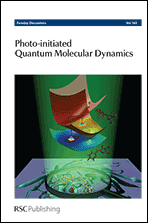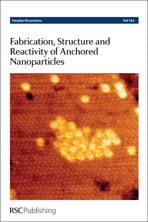This month sees the following articles in Faraday Discussions that are in the top 25 most accessed from April – June :
Hydrogen evolution on nano-particulate transition metal sulfides
Jacob Bonde, Poul G. Moses, Thomas F. Jaramillo, Jens K. Nørskov and Ib Chorkendorff
Faraday Discuss., 2009,140, 219-231
DOI: 10.1039/B803857K
Nanostructured materials for lithium-ion batteries: Surface conductivity vs. bulk ion/electron transport
B. Ellis, P. Subramanya Herle, Y.-H. Rho, L. F. Nazar, R. Dunlap, Laura K. Perry and D. H. Ryan
Faraday Discuss., 2007,134, 119-141
DOI: 10.1039/B602698B
Spontaneous tubulation of membranes and vesicles reveals membrane tension generated by spontaneous curvature
Reinhard Lipowsky
Faraday Discuss., 2013,161, 305-331
DOI: 10.1039/C2FD20105D
Artificial photosynthesis for solar fuels
Stenbjörn Styring
Faraday Discuss., 2012,155, 357-376
DOI: 10.1039/C1FD00113B
Introductory Lecture Surface enhanced Raman spectroscopy: new materials, concepts, characterization tools, and applications
Jon A. Dieringer, Adam D. McFarland, Nilam C. Shah, Douglas A. Stuart, Alyson V. Whitney, Chanda R. Yonzon, Matthew A. Young, Xiaoyu Zhang and Richard P. Van Duyne
Faraday Discuss., 2006,132, 9-26
DOI: 10.1039/B513431P
Anomalous and normal diffusion of proteins and lipids in crowded lipid membranes
Matti Javanainen, Henrik Hammaren, Luca Monticelli, Jae-Hyung Jeon, Markus S. Miettinen, Hector Martinez-Seara, Ralf Metzler and Ilpo Vattulainen
Faraday Discuss., 2013,161, 397-417
DOI: 10.1039/C2FD20085F
Ionic Liquids: Past, present and future
C. Austen Angell, Younes Ansari and Zuofeng Zhao
Faraday Discuss., 2012,154, 9-27
DOI: 10.1039/C1FD00112D
Micro-convection, dissipative structure and pattern formation in polymer blend solutions under temperature gradients
Takeshi Nambu, Yuji Yamauchi, Takahiro Kushiro and Shinichi Sakurai
Faraday Discuss., 2005,128, 285-298
DOI: 10.1039/B403108C
The thermodynamics of calcite nucleation at organic interfaces: Classical vs. non-classical pathways
Q. Hu, M. H. Nielsen, C. L. Freeman, L. M. Hamm, J. Tao, J. R. I. Lee, T. Y. J. Han, U. Becker, J. H. Harding, P. M. Dove and J. J. De Yoreo
Faraday Discuss., 2012,159, 509-523
DOI: 10.1039/C2FD20124K
Transparent superhydrophobic and highly oleophobic coatings
Liangliang Cao and Di Gao
Faraday Discuss., 2010,146, 57-65
DOI: 10.1039/C003392H
What is not required to make a single molecule magnet
Frank Neese and Dimitrios A. Pantazis
Faraday Discuss., 2011,148, 229-238
DOI: 10.1039/C005256F
Introductory Lecture: Basic quantities in model biomembranes
John F. Nagle
Faraday Discuss., 2013,161, 11-29
DOI: 10.1039/C2FD20121F
Switching-off toluene formation in the solvent-free oxidation of benzyl alcohol using supported trimetallic Au–Pd–Pt nanoparticles
Qian He, Peter J. Miedziak, Lokesh Kesavan, Nikolaos Dimitratos, Meenakshisundaram Sankar, Jose Antonio Lopez-Sanchez, Michael M. Forde, Jennifer K. Edwards, David W. Knight, Stuart H. Taylor, Christopher J. Kiely and Graham J. Hutchings
Faraday Discuss., 2013,162, 365-378
DOI: 10.1039/C2FD20153D
Gaussian curvature elasticity determined from global shape transformations and local stress distributions: a comparative study using the MARTINI model
Mingyang Hu, Djurre H. de Jong, Siewert J. Marrink and Markus Deserno
Faraday Discuss., 2013,161, 365-382
DOI: 10.1039/C2FD20087B
Introductory Lecture: Interpreting and predicting Hofmeister salt ion and solute effects on biopolymer and model processes using the solute partitioning model
M. Thomas Record, Emily Guinn, Laurel Pegram and Michael Capp
Faraday Discuss., 2013,160, 9-44
DOI: 10.1039/C2FD20128C
Light-driven water oxidation with a molecular tetra-cobalt(iii) cubane cluster
Giuseppina La Ganga, Fausto Puntoriero, Sebastiano Campagna, Irene Bazzan, Serena Berardi, Marcella Bonchio, Andrea Sartorel, Mirco Natali and Franco Scandola
Faraday Discuss., 2012,155, 177-190
DOI: 10.1039/C1FD00093D
Steady state oxygen reduction and cyclic voltammetry
Jan Rossmeisl, Gustav S. Karlberg, Thomas Jaramillo and Jens K. Nørskov
Faraday Discuss., 2009,140, 337-346
DOI: 10.1039/B802129E
Switchable domain partitioning and diffusion of DNA origami rods on membranes
Aleksander Czogalla, Eugene P. Petrov, Dominik J. Kauert, Veselina Uzunova, Yixin Zhang, Ralf Seidel and Petra Schwille
Faraday Discuss., 2013,161, 31-43
DOI: 10.1039/C2FD20109G
An ab initio approach to understanding the specific ion effect
Marcel D. Baer and Christopher J. Mundy
Faraday Discuss., 2013,160, 89-101
DOI: 10.1039/C2FD20113E
Realizing artificial photosynthesis
Devens Gust, Thomas A. Moore and Ana L. Moore
Faraday Discuss., 2012,155, 9-26
DOI: 10.1039/C1FD00110H
The effect of cholesterol on the intrinsic rate of lipid flip–flop as measured by sum-frequency vibrational spectroscopy
Jin Liu, Krystal L. Brown and John C. Conboy
Faraday Discuss., 2013,161, 45-61
DOI: 10.1039/C2FD20083J
Simultaneous frequency and dissipation factor QCM measurements of biomolecular adsorption and cell adhesion
Michael Rodahl, Fredrik Höök, Claes Fredriksson, Craig A. Keller, Anatol Krozer, Peter Brzezinski, Marina Voinova and Bengt Kasemo
Faraday Discuss., 1997,107, 229-246
DOI: 10.1039/A703137H
A first principles comparison of the mechanism and site requirements for the electrocatalytic oxidation of methanol and formic acid over Pt
Matthew Neurock, Michael Janik and Andrzej Wieckowski
Faraday Discuss., 2009,140, 363-378
DOI: 10.1039/B804591G
What ice can teach us about water interactions: a critical comparison of the performance of different water models
C. Vega, J. L. F. Abascal, M. M. Conde and J. L. Aragones
Faraday Discuss., 2009,141, 251-276
DOI: 10.1039/B805531A
Superhydrophobic surfaces by hybrid raspberry-like particles
Maria D’Acunzi, Lena Mammen, Maninderjit Singh, Xu Deng, Marcel Roth, Günter K. Auernhammer, Hans-Jürgen Butt and Doris Vollmer
Faraday Discuss., 2010,146, 35-48
DOI: 10.1039/B925676H
Why not take a look at the articles today and blog your thoughts and comments below.












 We are pleased to announce the publication of Faraday Discussion 163
We are pleased to announce the publication of Faraday Discussion 163  We are pleased to announce the publication of Faraday Discussion 162
We are pleased to announce the publication of Faraday Discussion 162 